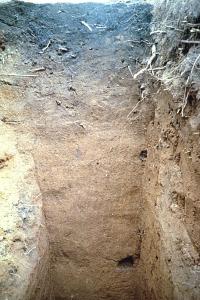Reference soil Mozambique 06: Acrisol
Acrisols occur dominantly in the wetter parts of the tropics and subtropics and the warm temperate regions in relatively young landscapes.
Characteristics
Soils having an argic horizon (a subsurface horizon with distinct higher clay content than the overlying horizon), which has a cation exchange capacity of less than 24 cmolc per kg in some part, either starting within 100 cm from the soil surface, or within 200 cm from the soil surface if the argic horizon is overlain by loamy sand or coarser textures throughout. They have a base saturation (total amount of Ca, Mg, K and Na with respect to the cation exchange capacity) of less than 50 percent in the major part between 25 and 100 cm from the soil surface
Reference soil MZ006: Acrisols
A deep, well drained, yellowish red sandy clay (loam) with a loamy sand topsoil and having a strongly mottled low permeable subsoil deeper than 150 cm. Texture is sandy clay from 93 to 121 cm. Medium to large size, dome and chimney shaped, termite mounds. The structure of the topsoil can also be described as single grain or massive porous/weakly coherent. In the topsoil are holes filled with redder coloured subsoil; in the subsoil are holes filled with darker coloured topsoil. At 90 cm depth one can observe a slight increase in clay content. Termite holes are present, density about 2 per square meter. The strong mottling in the subsoil is caused by temporarily stagnant water.
